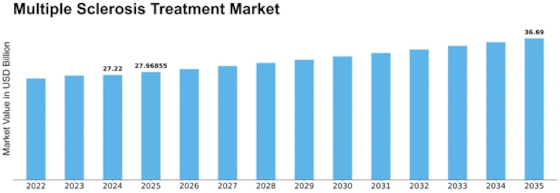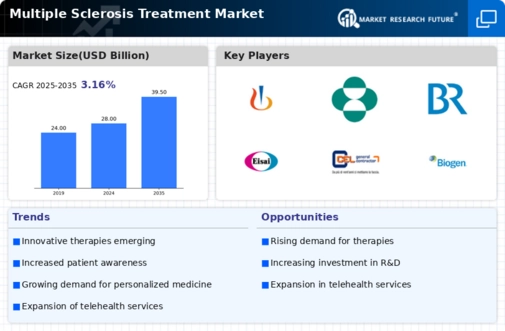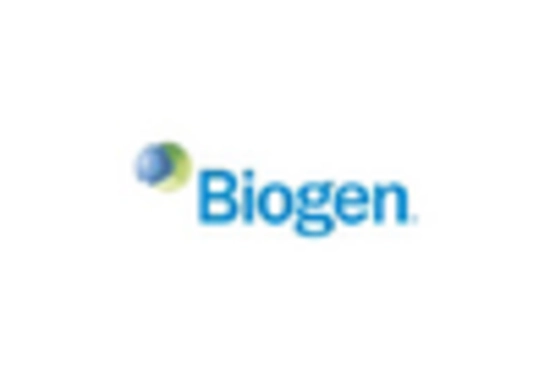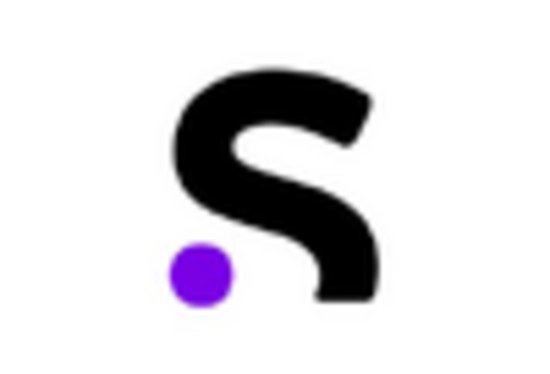-
EXECUTIVE SUMMARY
-
Market Overview
-
Key Findings
-
Market Segmentation
-
Competitive Landscape
-
Challenges and Opportunities
-
Future Outlook
-
MARKET INTRODUCTION
-
Definition
-
Scope of the study
- Research Objective
- Assumption
- Limitations
-
RESEARCH METHODOLOGY
-
Overview
-
Data Mining
-
Secondary Research
-
Primary Research
- Primary Interviews and Information Gathering Process
- Breakdown of Primary Respondents
-
Forecasting Model
-
Market Size Estimation
- Bottom-Up Approach
- Top-Down Approach
-
Data Triangulation
-
Validation
-
MARKET DYNAMICS
-
Overview
-
Drivers
-
Restraints
-
Opportunities
-
MARKET FACTOR ANALYSIS
-
Value chain Analysis
-
Porter's Five Forces Analysis
- Bargaining Power of Suppliers
- Bargaining Power of Buyers
- Threat of New Entrants
- Threat of Substitutes
- Intensity of Rivalry
-
COVID-19 Impact Analysis
- Market Impact Analysis
- Regional Impact
- Opportunity and Threat Analysis
-
MULTIPLE SCLEROSIS TREATMENT MARKET, BY DRUG TYPE (USD BILLION)
-
Disease-Modifying Therapies
-
Corticosteroids
-
Symptomatic Treatments
-
Monoclonal Antibodies
-
MULTIPLE SCLEROSIS TREATMENT MARKET, BY ROUTE OF ADMINISTRATION (USD BILLION)
-
Oral
-
Injectable
-
Intravenous
-
MULTIPLE SCLEROSIS TREATMENT MARKET, BY TREATMENT TYPE (USD BILLION)
-
Acute Treatment
-
Chronic Management
-
Rehabilitation
-
MULTIPLE SCLEROSIS TREATMENT MARKET, BY PATIENT TYPE (USD BILLION)
-
Pediatric Patients
-
Adult Patients
-
Geriatric Patients
-
MULTIPLE SCLEROSIS TREATMENT MARKET, BY REGIONAL (USD BILLION)
-
North America
- US
- Canada
-
Europe
- Germany
- UK
- France
- Russia
- Italy
- Spain
- Rest of Europe
-
APAC
- China
- India
- Japan
- South Korea
- Malaysia
- Thailand
- Indonesia
- Rest of APAC
-
South America
- Brazil
- Mexico
- Argentina
- Rest of South America
-
MEA
- GCC Countries
- South Africa
- Rest of MEA
-
COMPETITIVE LANDSCAPE
-
Overview
-
Competitive Analysis
-
Market share Analysis
-
Major Growth Strategy in the Multiple Sclerosis Treatment Market
-
Competitive Benchmarking
-
Leading Players in Terms of Number of Developments in the Multiple Sclerosis Treatment Market
-
Key developments and growth strategies
- New Product Launch/Service Deployment
- Merger & Acquisitions
- Joint Ventures
-
Major Players Financial Matrix
- Sales and Operating Income
- Major Players R&D Expenditure. 2023
-
COMPANY PROFILES
-
Acorda Therapeutics
- Financial Overview
- Products Offered
- Key Developments
- SWOT Analysis
- Key Strategies
-
Roche
- Financial Overview
- Products Offered
- Key Developments
- SWOT Analysis
- Key Strategies
-
AbbVie
- Financial Overview
- Products Offered
- Key Developments
- SWOT Analysis
- Key Strategies
-
Bristol Myers Squibb
- Financial Overview
- Products Offered
- Key Developments
- SWOT Analysis
- Key Strategies
-
Genzyme
- Financial Overview
- Products Offered
- Key Developments
- SWOT Analysis
- Key Strategies
-
Biogen
- Financial Overview
- Products Offered
- Key Developments
- SWOT Analysis
- Key Strategies
-
Eisai
- Financial Overview
- Products Offered
- Key Developments
- SWOT Analysis
- Key Strategies
-
Novartis
- Financial Overview
- Products Offered
- Key Developments
- SWOT Analysis
- Key Strategies
-
Celgene
- Financial Overview
- Products Offered
- Key Developments
- SWOT Analysis
- Key Strategies
-
Teva Pharmaceuticals
- Financial Overview
- Products Offered
- Key Developments
- SWOT Analysis
- Key Strategies
-
Zynovus
- Financial Overview
- Products Offered
- Key Developments
- SWOT Analysis
- Key Strategies
-
Helsinn Healthcare
- Financial Overview
- Products Offered
- Key Developments
- SWOT Analysis
- Key Strategies
-
Merck
- Financial Overview
- Products Offered
- Key Developments
- SWOT Analysis
- Key Strategies
-
Amgen
- Financial Overview
- Products Offered
- Key Developments
- SWOT Analysis
- Key Strategies
-
Sanofi
- Financial Overview
- Products Offered
- Key Developments
- SWOT Analysis
- Key Strategies
-
APPENDIX
-
References
-
Related Reports
-
LIST OF TABLES
-
LIST OF ASSUMPTIONS
-
NORTH AMERICA MULTIPLE SCLEROSIS TREATMENT MARKET SIZE ESTIMATES & FORECAST, BY DRUG TYPE, 2019-2035 (USD BILLIONS)
-
NORTH AMERICA MULTIPLE SCLEROSIS TREATMENT MARKET SIZE ESTIMATES & FORECAST, BY ROUTE OF ADMINISTRATION, 2019-2035 (USD BILLIONS)
-
NORTH AMERICA MULTIPLE SCLEROSIS TREATMENT MARKET SIZE ESTIMATES & FORECAST, BY TREATMENT TYPE, 2019-2035 (USD BILLIONS)
-
NORTH AMERICA MULTIPLE SCLEROSIS TREATMENT MARKET SIZE ESTIMATES & FORECAST, BY PATIENT TYPE, 2019-2035 (USD BILLIONS)
-
NORTH AMERICA MULTIPLE SCLEROSIS TREATMENT MARKET SIZE ESTIMATES & FORECAST, BY REGIONAL, 2019-2035 (USD BILLIONS)
-
US MULTIPLE SCLEROSIS TREATMENT MARKET SIZE ESTIMATES & FORECAST, BY DRUG TYPE, 2019-2035 (USD BILLIONS)
-
US MULTIPLE SCLEROSIS TREATMENT MARKET SIZE ESTIMATES & FORECAST, BY ROUTE OF ADMINISTRATION, 2019-2035 (USD BILLIONS)
-
US MULTIPLE SCLEROSIS TREATMENT MARKET SIZE ESTIMATES & FORECAST, BY TREATMENT TYPE, 2019-2035 (USD BILLIONS)
-
US MULTIPLE SCLEROSIS TREATMENT MARKET SIZE ESTIMATES & FORECAST, BY PATIENT TYPE, 2019-2035 (USD BILLIONS)
-
US MULTIPLE SCLEROSIS TREATMENT MARKET SIZE ESTIMATES & FORECAST, BY REGIONAL, 2019-2035 (USD BILLIONS)
-
CANADA MULTIPLE SCLEROSIS TREATMENT MARKET SIZE ESTIMATES & FORECAST, BY DRUG TYPE, 2019-2035 (USD BILLIONS)
-
CANADA MULTIPLE SCLEROSIS TREATMENT MARKET SIZE ESTIMATES & FORECAST, BY ROUTE OF ADMINISTRATION, 2019-2035 (USD BILLIONS)
-
CANADA MULTIPLE SCLEROSIS TREATMENT MARKET SIZE ESTIMATES & FORECAST, BY TREATMENT TYPE, 2019-2035 (USD BILLIONS)
-
CANADA MULTIPLE SCLEROSIS TREATMENT MARKET SIZE ESTIMATES & FORECAST, BY PATIENT TYPE, 2019-2035 (USD BILLIONS)
-
CANADA MULTIPLE SCLEROSIS TREATMENT MARKET SIZE ESTIMATES & FORECAST, BY REGIONAL, 2019-2035 (USD BILLIONS)
-
EUROPE MULTIPLE SCLEROSIS TREATMENT MARKET SIZE ESTIMATES & FORECAST, BY DRUG TYPE, 2019-2035 (USD BILLIONS)
-
EUROPE MULTIPLE SCLEROSIS TREATMENT MARKET SIZE ESTIMATES & FORECAST, BY ROUTE OF ADMINISTRATION, 2019-2035 (USD BILLIONS)
-
EUROPE MULTIPLE SCLEROSIS TREATMENT MARKET SIZE ESTIMATES & FORECAST, BY TREATMENT TYPE, 2019-2035 (USD BILLIONS)
-
EUROPE MULTIPLE SCLEROSIS TREATMENT MARKET SIZE ESTIMATES & FORECAST, BY PATIENT TYPE, 2019-2035 (USD BILLIONS)
-
EUROPE MULTIPLE SCLEROSIS TREATMENT MARKET SIZE ESTIMATES & FORECAST, BY REGIONAL, 2019-2035 (USD BILLIONS)
-
GERMANY MULTIPLE SCLEROSIS TREATMENT MARKET SIZE ESTIMATES & FORECAST, BY DRUG TYPE, 2019-2035 (USD BILLIONS)
-
GERMANY MULTIPLE SCLEROSIS TREATMENT MARKET SIZE ESTIMATES & FORECAST, BY ROUTE OF ADMINISTRATION, 2019-2035 (USD BILLIONS)
-
GERMANY MULTIPLE SCLEROSIS TREATMENT MARKET SIZE ESTIMATES & FORECAST, BY TREATMENT TYPE, 2019-2035 (USD BILLIONS)
-
GERMANY MULTIPLE SCLEROSIS TREATMENT MARKET SIZE ESTIMATES & FORECAST, BY PATIENT TYPE, 2019-2035 (USD BILLIONS)
-
GERMANY MULTIPLE SCLEROSIS TREATMENT MARKET SIZE ESTIMATES & FORECAST, BY REGIONAL, 2019-2035 (USD BILLIONS)
-
UK MULTIPLE SCLEROSIS TREATMENT MARKET SIZE ESTIMATES & FORECAST, BY DRUG TYPE, 2019-2035 (USD BILLIONS)
-
UK MULTIPLE SCLEROSIS TREATMENT MARKET SIZE ESTIMATES & FORECAST, BY ROUTE OF ADMINISTRATION, 2019-2035 (USD BILLIONS)
-
UK MULTIPLE SCLEROSIS TREATMENT MARKET SIZE ESTIMATES & FORECAST, BY TREATMENT TYPE, 2019-2035 (USD BILLIONS)
-
UK MULTIPLE SCLEROSIS TREATMENT MARKET SIZE ESTIMATES & FORECAST, BY PATIENT TYPE, 2019-2035 (USD BILLIONS)
-
UK MULTIPLE SCLEROSIS TREATMENT MARKET SIZE ESTIMATES & FORECAST, BY REGIONAL, 2019-2035 (USD BILLIONS)
-
FRANCE MULTIPLE SCLEROSIS TREATMENT MARKET SIZE ESTIMATES & FORECAST, BY DRUG TYPE, 2019-2035 (USD BILLIONS)
-
FRANCE MULTIPLE SCLEROSIS TREATMENT MARKET SIZE ESTIMATES & FORECAST, BY ROUTE OF ADMINISTRATION, 2019-2035 (USD BILLIONS)
-
FRANCE MULTIPLE SCLEROSIS TREATMENT MARKET SIZE ESTIMATES & FORECAST, BY TREATMENT TYPE, 2019-2035 (USD BILLIONS)
-
FRANCE MULTIPLE SCLEROSIS TREATMENT MARKET SIZE ESTIMATES & FORECAST, BY PATIENT TYPE, 2019-2035 (USD BILLIONS)
-
FRANCE MULTIPLE SCLEROSIS TREATMENT MARKET SIZE ESTIMATES & FORECAST, BY REGIONAL, 2019-2035 (USD BILLIONS)
-
RUSSIA MULTIPLE SCLEROSIS TREATMENT MARKET SIZE ESTIMATES & FORECAST, BY DRUG TYPE, 2019-2035 (USD BILLIONS)
-
RUSSIA MULTIPLE SCLEROSIS TREATMENT MARKET SIZE ESTIMATES & FORECAST, BY ROUTE OF ADMINISTRATION, 2019-2035 (USD BILLIONS)
-
RUSSIA MULTIPLE SCLEROSIS TREATMENT MARKET SIZE ESTIMATES & FORECAST, BY TREATMENT TYPE, 2019-2035 (USD BILLIONS)
-
RUSSIA MULTIPLE SCLEROSIS TREATMENT MARKET SIZE ESTIMATES & FORECAST, BY PATIENT TYPE, 2019-2035 (USD BILLIONS)
-
RUSSIA MULTIPLE SCLEROSIS TREATMENT MARKET SIZE ESTIMATES & FORECAST, BY REGIONAL, 2019-2035 (USD BILLIONS)
-
ITALY MULTIPLE SCLEROSIS TREATMENT MARKET SIZE ESTIMATES & FORECAST, BY DRUG TYPE, 2019-2035 (USD BILLIONS)
-
ITALY MULTIPLE SCLEROSIS TREATMENT MARKET SIZE ESTIMATES & FORECAST, BY ROUTE OF ADMINISTRATION, 2019-2035 (USD BILLIONS)
-
ITALY MULTIPLE SCLEROSIS TREATMENT MARKET SIZE ESTIMATES & FORECAST, BY TREATMENT TYPE, 2019-2035 (USD BILLIONS)
-
ITALY MULTIPLE SCLEROSIS TREATMENT MARKET SIZE ESTIMATES & FORECAST, BY PATIENT TYPE, 2019-2035 (USD BILLIONS)
-
ITALY MULTIPLE SCLEROSIS TREATMENT MARKET SIZE ESTIMATES & FORECAST, BY REGIONAL, 2019-2035 (USD BILLIONS)
-
SPAIN MULTIPLE SCLEROSIS TREATMENT MARKET SIZE ESTIMATES & FORECAST, BY DRUG TYPE, 2019-2035 (USD BILLIONS)
-
SPAIN MULTIPLE SCLEROSIS TREATMENT MARKET SIZE ESTIMATES & FORECAST, BY ROUTE OF ADMINISTRATION, 2019-2035 (USD BILLIONS)
-
SPAIN MULTIPLE SCLEROSIS TREATMENT MARKET SIZE ESTIMATES & FORECAST, BY TREATMENT TYPE, 2019-2035 (USD BILLIONS)
-
SPAIN MULTIPLE SCLEROSIS TREATMENT MARKET SIZE ESTIMATES & FORECAST, BY PATIENT TYPE, 2019-2035 (USD BILLIONS)
-
SPAIN MULTIPLE SCLEROSIS TREATMENT MARKET SIZE ESTIMATES & FORECAST, BY REGIONAL, 2019-2035 (USD BILLIONS)
-
REST OF EUROPE MULTIPLE SCLEROSIS TREATMENT MARKET SIZE ESTIMATES & FORECAST, BY DRUG TYPE, 2019-2035 (USD BILLIONS)
-
REST OF EUROPE MULTIPLE SCLEROSIS TREATMENT MARKET SIZE ESTIMATES & FORECAST, BY ROUTE OF ADMINISTRATION, 2019-2035 (USD BILLIONS)
-
REST OF EUROPE MULTIPLE SCLEROSIS TREATMENT MARKET SIZE ESTIMATES & FORECAST, BY TREATMENT TYPE, 2019-2035 (USD BILLIONS)
-
REST OF EUROPE MULTIPLE SCLEROSIS TREATMENT MARKET SIZE ESTIMATES & FORECAST, BY PATIENT TYPE, 2019-2035 (USD BILLIONS)
-
REST OF EUROPE MULTIPLE SCLEROSIS TREATMENT MARKET SIZE ESTIMATES & FORECAST, BY REGIONAL, 2019-2035 (USD BILLIONS)
-
APAC MULTIPLE SCLEROSIS TREATMENT MARKET SIZE ESTIMATES & FORECAST, BY DRUG TYPE, 2019-2035 (USD BILLIONS)
-
APAC MULTIPLE SCLEROSIS TREATMENT MARKET SIZE ESTIMATES & FORECAST, BY ROUTE OF ADMINISTRATION, 2019-2035 (USD BILLIONS)
-
APAC MULTIPLE SCLEROSIS TREATMENT MARKET SIZE ESTIMATES & FORECAST, BY TREATMENT TYPE, 2019-2035 (USD BILLIONS)
-
APAC MULTIPLE SCLEROSIS TREATMENT MARKET SIZE ESTIMATES & FORECAST, BY PATIENT TYPE, 2019-2035 (USD BILLIONS)
-
APAC MULTIPLE SCLEROSIS TREATMENT MARKET SIZE ESTIMATES & FORECAST, BY REGIONAL, 2019-2035 (USD BILLIONS)
-
CHINA MULTIPLE SCLEROSIS TREATMENT MARKET SIZE ESTIMATES & FORECAST, BY DRUG TYPE, 2019-2035 (USD BILLIONS)
-
CHINA MULTIPLE SCLEROSIS TREATMENT MARKET SIZE ESTIMATES & FORECAST, BY ROUTE OF ADMINISTRATION, 2019-2035 (USD BILLIONS)
-
CHINA MULTIPLE SCLEROSIS TREATMENT MARKET SIZE ESTIMATES & FORECAST, BY TREATMENT TYPE, 2019-2035 (USD BILLIONS)
-
CHINA MULTIPLE SCLEROSIS TREATMENT MARKET SIZE ESTIMATES & FORECAST, BY PATIENT TYPE, 2019-2035 (USD BILLIONS)
-
CHINA MULTIPLE SCLEROSIS TREATMENT MARKET SIZE ESTIMATES & FORECAST, BY REGIONAL, 2019-2035 (USD BILLIONS)
-
INDIA MULTIPLE SCLEROSIS TREATMENT MARKET SIZE ESTIMATES & FORECAST, BY DRUG TYPE, 2019-2035 (USD BILLIONS)
-
INDIA MULTIPLE SCLEROSIS TREATMENT MARKET SIZE ESTIMATES & FORECAST, BY ROUTE OF ADMINISTRATION, 2019-2035 (USD BILLIONS)
-
INDIA MULTIPLE SCLEROSIS TREATMENT MARKET SIZE ESTIMATES & FORECAST, BY TREATMENT TYPE, 2019-2035 (USD BILLIONS)
-
INDIA MULTIPLE SCLEROSIS TREATMENT MARKET SIZE ESTIMATES & FORECAST, BY PATIENT TYPE, 2019-2035 (USD BILLIONS)
-
INDIA MULTIPLE SCLEROSIS TREATMENT MARKET SIZE ESTIMATES & FORECAST, BY REGIONAL, 2019-2035 (USD BILLIONS)
-
JAPAN MULTIPLE SCLEROSIS TREATMENT MARKET SIZE ESTIMATES & FORECAST, BY DRUG TYPE, 2019-2035 (USD BILLIONS)
-
JAPAN MULTIPLE SCLEROSIS TREATMENT MARKET SIZE ESTIMATES & FORECAST, BY ROUTE OF ADMINISTRATION, 2019-2035 (USD BILLIONS)
-
JAPAN MULTIPLE SCLEROSIS TREATMENT MARKET SIZE ESTIMATES & FORECAST, BY TREATMENT TYPE, 2019-2035 (USD BILLIONS)
-
JAPAN MULTIPLE SCLEROSIS TREATMENT MARKET SIZE ESTIMATES & FORECAST, BY PATIENT TYPE, 2019-2035 (USD BILLIONS)
-
JAPAN MULTIPLE SCLEROSIS TREATMENT MARKET SIZE ESTIMATES & FORECAST, BY REGIONAL, 2019-2035 (USD BILLIONS)
-
SOUTH KOREA MULTIPLE SCLEROSIS TREATMENT MARKET SIZE ESTIMATES & FORECAST, BY DRUG TYPE, 2019-2035 (USD BILLIONS)
-
SOUTH KOREA MULTIPLE SCLEROSIS TREATMENT MARKET SIZE ESTIMATES & FORECAST, BY ROUTE OF ADMINISTRATION, 2019-2035 (USD BILLIONS)
-
SOUTH KOREA MULTIPLE SCLEROSIS TREATMENT MARKET SIZE ESTIMATES & FORECAST, BY TREATMENT TYPE, 2019-2035 (USD BILLIONS)
-
SOUTH KOREA MULTIPLE SCLEROSIS TREATMENT MARKET SIZE ESTIMATES & FORECAST, BY PATIENT TYPE, 2019-2035 (USD BILLIONS)
-
SOUTH KOREA MULTIPLE SCLEROSIS TREATMENT MARKET SIZE ESTIMATES & FORECAST, BY REGIONAL, 2019-2035 (USD BILLIONS)
-
MALAYSIA MULTIPLE SCLEROSIS TREATMENT MARKET SIZE ESTIMATES & FORECAST, BY DRUG TYPE, 2019-2035 (USD BILLIONS)
-
MALAYSIA MULTIPLE SCLEROSIS TREATMENT MARKET SIZE ESTIMATES & FORECAST, BY ROUTE OF ADMINISTRATION, 2019-2035 (USD BILLIONS)
-
MALAYSIA MULTIPLE SCLEROSIS TREATMENT MARKET SIZE ESTIMATES & FORECAST, BY TREATMENT TYPE, 2019-2035 (USD BILLIONS)
-
MALAYSIA MULTIPLE SCLEROSIS TREATMENT MARKET SIZE ESTIMATES & FORECAST, BY PATIENT TYPE, 2019-2035 (USD BILLIONS)
-
MALAYSIA MULTIPLE SCLEROSIS TREATMENT MARKET SIZE ESTIMATES & FORECAST, BY REGIONAL, 2019-2035 (USD BILLIONS)
-
THAILAND MULTIPLE SCLEROSIS TREATMENT MARKET SIZE ESTIMATES & FORECAST, BY DRUG TYPE, 2019-2035 (USD BILLIONS)
-
THAILAND MULTIPLE SCLEROSIS TREATMENT MARKET SIZE ESTIMATES & FORECAST, BY ROUTE OF ADMINISTRATION, 2019-2035 (USD BILLIONS)
-
THAILAND MULTIPLE SCLEROSIS TREATMENT MARKET SIZE ESTIMATES & FORECAST, BY TREATMENT TYPE, 2019-2035 (USD BILLIONS)
-
THAILAND MULTIPLE SCLEROSIS TREATMENT MARKET SIZE ESTIMATES & FORECAST, BY PATIENT TYPE, 2019-2035 (USD BILLIONS)
-
THAILAND MULTIPLE SCLEROSIS TREATMENT MARKET SIZE ESTIMATES & FORECAST, BY REGIONAL, 2019-2035 (USD BILLIONS)
-
INDONESIA MULTIPLE SCLEROSIS TREATMENT MARKET SIZE ESTIMATES & FORECAST, BY DRUG TYPE, 2019-2035 (USD BILLIONS)
-
INDONESIA MULTIPLE SCLEROSIS TREATMENT MARKET SIZE ESTIMATES & FORECAST, BY ROUTE OF ADMINISTRATION, 2019-2035 (USD BILLIONS)
-
INDONESIA MULTIPLE SCLEROSIS TREATMENT MARKET SIZE ESTIMATES & FORECAST, BY TREATMENT TYPE, 2019-2035 (USD BILLIONS)
-
INDONESIA MULTIPLE SCLEROSIS TREATMENT MARKET SIZE ESTIMATES & FORECAST, BY PATIENT TYPE, 2019-2035 (USD BILLIONS)
-
INDONESIA MULTIPLE SCLEROSIS TREATMENT MARKET SIZE ESTIMATES & FORECAST, BY REGIONAL, 2019-2035 (USD BILLIONS)
-
REST OF APAC MULTIPLE SCLEROSIS TREATMENT MARKET SIZE ESTIMATES & FORECAST, BY DRUG TYPE, 2019-2035 (USD BILLIONS)
-
REST OF APAC MULTIPLE SCLEROSIS TREATMENT MARKET SIZE ESTIMATES & FORECAST, BY ROUTE OF ADMINISTRATION, 2019-2035 (USD BILLIONS)
-
REST OF APAC MULTIPLE SCLEROSIS TREATMENT MARKET SIZE ESTIMATES & FORECAST, BY TREATMENT TYPE, 2019-2035 (USD BILLIONS)
-
REST OF APAC MULTIPLE SCLEROSIS TREATMENT MARKET SIZE ESTIMATES & FORECAST, BY PATIENT TYPE, 2019-2035 (USD BILLIONS)
-
REST OF APAC MULTIPLE SCLEROSIS TREATMENT MARKET SIZE ESTIMATES & FORECAST, BY REGIONAL, 2019-2035 (USD BILLIONS)
-
SOUTH AMERICA MULTIPLE SCLEROSIS TREATMENT MARKET SIZE ESTIMATES & FORECAST, BY DRUG TYPE, 2019-2035 (USD BILLIONS)
-
SOUTH AMERICA MULTIPLE SCLEROSIS TREATMENT MARKET SIZE ESTIMATES & FORECAST, BY ROUTE OF ADMINISTRATION, 2019-2035 (USD BILLIONS)
-
SOUTH AMERICA MULTIPLE SCLEROSIS TREATMENT MARKET SIZE ESTIMATES & FORECAST, BY TREATMENT TYPE, 2019-2035 (USD BILLIONS)
-
SOUTH AMERICA MULTIPLE SCLEROSIS TREATMENT MARKET SIZE ESTIMATES & FORECAST, BY PATIENT TYPE, 2019-2035 (USD BILLIONS)
-
SOUTH AMERICA MULTIPLE SCLEROSIS TREATMENT MARKET SIZE ESTIMATES & FORECAST, BY REGIONAL, 2019-2035 (USD BILLIONS)
-
BRAZIL MULTIPLE SCLEROSIS TREATMENT MARKET SIZE ESTIMATES & FORECAST, BY DRUG TYPE, 2019-2035 (USD BILLIONS)
-
BRAZIL MULTIPLE SCLEROSIS TREATMENT MARKET SIZE ESTIMATES & FORECAST, BY ROUTE OF ADMINISTRATION, 2019-2035 (USD BILLIONS)
-
BRAZIL MULTIPLE SCLEROSIS TREATMENT MARKET SIZE ESTIMATES & FORECAST, BY TREATMENT TYPE, 2019-2035 (USD BILLIONS)
-
BRAZIL MULTIPLE SCLEROSIS TREATMENT MARKET SIZE ESTIMATES & FORECAST, BY PATIENT TYPE, 2019-2035 (USD BILLIONS)
-
BRAZIL MULTIPLE SCLEROSIS TREATMENT MARKET SIZE ESTIMATES & FORECAST, BY REGIONAL, 2019-2035 (USD BILLIONS)
-
MEXICO MULTIPLE SCLEROSIS TREATMENT MARKET SIZE ESTIMATES & FORECAST, BY DRUG TYPE, 2019-2035 (USD BILLIONS)
-
MEXICO MULTIPLE SCLEROSIS TREATMENT MARKET SIZE ESTIMATES & FORECAST, BY ROUTE OF ADMINISTRATION, 2019-2035 (USD BILLIONS)
-
MEXICO MULTIPLE SCLEROSIS TREATMENT MARKET SIZE ESTIMATES & FORECAST, BY TREATMENT TYPE, 2019-2035 (USD BILLIONS)
-
MEXICO MULTIPLE SCLEROSIS TREATMENT MARKET SIZE ESTIMATES & FORECAST, BY PATIENT TYPE, 2019-2035 (USD BILLIONS)
-
MEXICO MULTIPLE SCLEROSIS TREATMENT MARKET SIZE ESTIMATES & FORECAST, BY REGIONAL, 2019-2035 (USD BILLIONS)
-
ARGENTINA MULTIPLE SCLEROSIS TREATMENT MARKET SIZE ESTIMATES & FORECAST, BY DRUG TYPE, 2019-2035 (USD BILLIONS)
-
ARGENTINA MULTIPLE SCLEROSIS TREATMENT MARKET SIZE ESTIMATES & FORECAST, BY ROUTE OF ADMINISTRATION, 2019-2035 (USD BILLIONS)
-
ARGENTINA MULTIPLE SCLEROSIS TREATMENT MARKET SIZE ESTIMATES & FORECAST, BY TREATMENT TYPE, 2019-2035 (USD BILLIONS)
-
ARGENTINA MULTIPLE SCLEROSIS TREATMENT MARKET SIZE ESTIMATES & FORECAST, BY PATIENT TYPE, 2019-2035 (USD BILLIONS)
-
ARGENTINA MULTIPLE SCLEROSIS TREATMENT MARKET SIZE ESTIMATES & FORECAST, BY REGIONAL, 2019-2035 (USD BILLIONS)
-
REST OF SOUTH AMERICA MULTIPLE SCLEROSIS TREATMENT MARKET SIZE ESTIMATES & FORECAST, BY DRUG TYPE, 2019-2035 (USD BILLIONS)
-
REST OF SOUTH AMERICA MULTIPLE SCLEROSIS TREATMENT MARKET SIZE ESTIMATES & FORECAST, BY ROUTE OF ADMINISTRATION, 2019-2035 (USD BILLIONS)
-
REST OF SOUTH AMERICA MULTIPLE SCLEROSIS TREATMENT MARKET SIZE ESTIMATES & FORECAST, BY TREATMENT TYPE, 2019-2035 (USD BILLIONS)
-
REST OF SOUTH AMERICA MULTIPLE SCLEROSIS TREATMENT MARKET SIZE ESTIMATES & FORECAST, BY PATIENT TYPE, 2019-2035 (USD BILLIONS)
-
REST OF SOUTH AMERICA MULTIPLE SCLEROSIS TREATMENT MARKET SIZE ESTIMATES & FORECAST, BY REGIONAL, 2019-2035 (USD BILLIONS)
-
MEA MULTIPLE SCLEROSIS TREATMENT MARKET SIZE ESTIMATES & FORECAST, BY DRUG TYPE, 2019-2035 (USD BILLIONS)
-
MEA MULTIPLE SCLEROSIS TREATMENT MARKET SIZE ESTIMATES & FORECAST, BY ROUTE OF ADMINISTRATION, 2019-2035 (USD BILLIONS)
-
MEA MULTIPLE SCLEROSIS TREATMENT MARKET SIZE ESTIMATES & FORECAST, BY TREATMENT TYPE, 2019-2035 (USD BILLIONS)
-
MEA MULTIPLE SCLEROSIS TREATMENT MARKET SIZE ESTIMATES & FORECAST, BY PATIENT TYPE, 2019-2035 (USD BILLIONS)
-
MEA MULTIPLE SCLEROSIS TREATMENT MARKET SIZE ESTIMATES & FORECAST, BY REGIONAL, 2019-2035 (USD BILLIONS)
-
GCC COUNTRIES MULTIPLE SCLEROSIS TREATMENT MARKET SIZE ESTIMATES & FORECAST, BY DRUG TYPE, 2019-2035 (USD BILLIONS)
-
GCC COUNTRIES MULTIPLE SCLEROSIS TREATMENT MARKET SIZE ESTIMATES & FORECAST, BY ROUTE OF ADMINISTRATION, 2019-2035 (USD BILLIONS)
-
GCC COUNTRIES MULTIPLE SCLEROSIS TREATMENT MARKET SIZE ESTIMATES & FORECAST, BY TREATMENT TYPE, 2019-2035 (USD BILLIONS)
-
GCC COUNTRIES MULTIPLE SCLEROSIS TREATMENT MARKET SIZE ESTIMATES & FORECAST, BY PATIENT TYPE, 2019-2035 (USD BILLIONS)
-
GCC COUNTRIES MULTIPLE SCLEROSIS TREATMENT MARKET SIZE ESTIMATES & FORECAST, BY REGIONAL, 2019-2035 (USD BILLIONS)
-
SOUTH AFRICA MULTIPLE SCLEROSIS TREATMENT MARKET SIZE ESTIMATES & FORECAST, BY DRUG TYPE, 2019-2035 (USD BILLIONS)
-
SOUTH AFRICA MULTIPLE SCLEROSIS TREATMENT MARKET SIZE ESTIMATES & FORECAST, BY ROUTE OF ADMINISTRATION, 2019-2035 (USD BILLIONS)
-
SOUTH AFRICA MULTIPLE SCLEROSIS TREATMENT MARKET SIZE ESTIMATES & FORECAST, BY TREATMENT TYPE, 2019-2035 (USD BILLIONS)
-
SOUTH AFRICA MULTIPLE SCLEROSIS TREATMENT MARKET SIZE ESTIMATES & FORECAST, BY PATIENT TYPE, 2019-2035 (USD BILLIONS)
-
SOUTH AFRICA MULTIPLE SCLEROSIS TREATMENT MARKET SIZE ESTIMATES & FORECAST, BY REGIONAL, 2019-2035 (USD BILLIONS)
-
REST OF MEA MULTIPLE SCLEROSIS TREATMENT MARKET SIZE ESTIMATES & FORECAST, BY DRUG TYPE, 2019-2035 (USD BILLIONS)
-
REST OF MEA MULTIPLE SCLEROSIS TREATMENT MARKET SIZE ESTIMATES & FORECAST, BY ROUTE OF ADMINISTRATION, 2019-2035 (USD BILLIONS)
-
REST OF MEA MULTIPLE SCLEROSIS TREATMENT MARKET SIZE ESTIMATES & FORECAST, BY TREATMENT TYPE, 2019-2035 (USD BILLIONS)
-
REST OF MEA MULTIPLE SCLEROSIS TREATMENT MARKET SIZE ESTIMATES & FORECAST, BY PATIENT TYPE, 2019-2035 (USD BILLIONS)
-
REST OF MEA MULTIPLE SCLEROSIS TREATMENT MARKET SIZE ESTIMATES & FORECAST, BY REGIONAL, 2019-2035 (USD BILLIONS)
-
PRODUCT LAUNCH/PRODUCT DEVELOPMENT/APPROVAL
-
ACQUISITION/PARTNERSHIP
-
LIST OF FIGURES
-
MARKET SYNOPSIS
-
NORTH AMERICA MULTIPLE SCLEROSIS TREATMENT MARKET ANALYSIS
-
US MULTIPLE SCLEROSIS TREATMENT MARKET ANALYSIS BY DRUG TYPE
-
US MULTIPLE SCLEROSIS TREATMENT MARKET ANALYSIS BY ROUTE OF ADMINISTRATION
-
US MULTIPLE SCLEROSIS TREATMENT MARKET ANALYSIS BY TREATMENT TYPE
-
US MULTIPLE SCLEROSIS TREATMENT MARKET ANALYSIS BY PATIENT TYPE
-
US MULTIPLE SCLEROSIS TREATMENT MARKET ANALYSIS BY REGIONAL
-
CANADA MULTIPLE SCLEROSIS TREATMENT MARKET ANALYSIS BY DRUG TYPE
-
CANADA MULTIPLE SCLEROSIS TREATMENT MARKET ANALYSIS BY ROUTE OF ADMINISTRATION
-
CANADA MULTIPLE SCLEROSIS TREATMENT MARKET ANALYSIS BY TREATMENT TYPE
-
CANADA MULTIPLE SCLEROSIS TREATMENT MARKET ANALYSIS BY PATIENT TYPE
-
CANADA MULTIPLE SCLEROSIS TREATMENT MARKET ANALYSIS BY REGIONAL
-
EUROPE MULTIPLE SCLEROSIS TREATMENT MARKET ANALYSIS
-
GERMANY MULTIPLE SCLEROSIS TREATMENT MARKET ANALYSIS BY DRUG TYPE
-
GERMANY MULTIPLE SCLEROSIS TREATMENT MARKET ANALYSIS BY ROUTE OF ADMINISTRATION
-
GERMANY MULTIPLE SCLEROSIS TREATMENT MARKET ANALYSIS BY TREATMENT TYPE
-
GERMANY MULTIPLE SCLEROSIS TREATMENT MARKET ANALYSIS BY PATIENT TYPE
-
GERMANY MULTIPLE SCLEROSIS TREATMENT MARKET ANALYSIS BY REGIONAL
-
UK MULTIPLE SCLEROSIS TREATMENT MARKET ANALYSIS BY DRUG TYPE
-
UK MULTIPLE SCLEROSIS TREATMENT MARKET ANALYSIS BY ROUTE OF ADMINISTRATION
-
UK MULTIPLE SCLEROSIS TREATMENT MARKET ANALYSIS BY TREATMENT TYPE
-
UK MULTIPLE SCLEROSIS TREATMENT MARKET ANALYSIS BY PATIENT TYPE
-
UK MULTIPLE SCLEROSIS TREATMENT MARKET ANALYSIS BY REGIONAL
-
FRANCE MULTIPLE SCLEROSIS TREATMENT MARKET ANALYSIS BY DRUG TYPE
-
FRANCE MULTIPLE SCLEROSIS TREATMENT MARKET ANALYSIS BY ROUTE OF ADMINISTRATION
-
FRANCE MULTIPLE SCLEROSIS TREATMENT MARKET ANALYSIS BY TREATMENT TYPE
-
FRANCE MULTIPLE SCLEROSIS TREATMENT MARKET ANALYSIS BY PATIENT TYPE
-
FRANCE MULTIPLE SCLEROSIS TREATMENT MARKET ANALYSIS BY REGIONAL
-
RUSSIA MULTIPLE SCLEROSIS TREATMENT MARKET ANALYSIS BY DRUG TYPE
-
RUSSIA MULTIPLE SCLEROSIS TREATMENT MARKET ANALYSIS BY ROUTE OF ADMINISTRATION
-
RUSSIA MULTIPLE SCLEROSIS TREATMENT MARKET ANALYSIS BY TREATMENT TYPE
-
RUSSIA MULTIPLE SCLEROSIS TREATMENT MARKET ANALYSIS BY PATIENT TYPE
-
RUSSIA MULTIPLE SCLEROSIS TREATMENT MARKET ANALYSIS BY REGIONAL
-
ITALY MULTIPLE SCLEROSIS TREATMENT MARKET ANALYSIS BY DRUG TYPE
-
ITALY MULTIPLE SCLEROSIS TREATMENT MARKET ANALYSIS BY ROUTE OF ADMINISTRATION
-
ITALY MULTIPLE SCLEROSIS TREATMENT MARKET ANALYSIS BY TREATMENT TYPE
-
ITALY MULTIPLE SCLEROSIS TREATMENT MARKET ANALYSIS BY PATIENT TYPE
-
ITALY MULTIPLE SCLEROSIS TREATMENT MARKET ANALYSIS BY REGIONAL
-
SPAIN MULTIPLE SCLEROSIS TREATMENT MARKET ANALYSIS BY DRUG TYPE
-
SPAIN MULTIPLE SCLEROSIS TREATMENT MARKET ANALYSIS BY ROUTE OF ADMINISTRATION
-
SPAIN MULTIPLE SCLEROSIS TREATMENT MARKET ANALYSIS BY TREATMENT TYPE
-
SPAIN MULTIPLE SCLEROSIS TREATMENT MARKET ANALYSIS BY PATIENT TYPE
-
SPAIN MULTIPLE SCLEROSIS TREATMENT MARKET ANALYSIS BY REGIONAL
-
REST OF EUROPE MULTIPLE SCLEROSIS TREATMENT MARKET ANALYSIS BY DRUG TYPE
-
REST OF EUROPE MULTIPLE SCLEROSIS TREATMENT MARKET ANALYSIS BY ROUTE OF ADMINISTRATION
-
REST OF EUROPE MULTIPLE SCLEROSIS TREATMENT MARKET ANALYSIS BY TREATMENT TYPE
-
REST OF EUROPE MULTIPLE SCLEROSIS TREATMENT MARKET ANALYSIS BY PATIENT TYPE
-
REST OF EUROPE MULTIPLE SCLEROSIS TREATMENT MARKET ANALYSIS BY REGIONAL
-
APAC MULTIPLE SCLEROSIS TREATMENT MARKET ANALYSIS
-
CHINA MULTIPLE SCLEROSIS TREATMENT MARKET ANALYSIS BY DRUG TYPE
-
CHINA MULTIPLE SCLEROSIS TREATMENT MARKET ANALYSIS BY ROUTE OF ADMINISTRATION
-
CHINA MULTIPLE SCLEROSIS TREATMENT MARKET ANALYSIS BY TREATMENT TYPE
-
CHINA MULTIPLE SCLEROSIS TREATMENT MARKET ANALYSIS BY PATIENT TYPE
-
CHINA MULTIPLE SCLEROSIS TREATMENT MARKET ANALYSIS BY REGIONAL
-
INDIA MULTIPLE SCLEROSIS TREATMENT MARKET ANALYSIS BY DRUG TYPE
-
INDIA MULTIPLE SCLEROSIS TREATMENT MARKET ANALYSIS BY ROUTE OF ADMINISTRATION
-
INDIA MULTIPLE SCLEROSIS TREATMENT MARKET ANALYSIS BY TREATMENT TYPE
-
INDIA MULTIPLE SCLEROSIS TREATMENT MARKET ANALYSIS BY PATIENT TYPE
-
INDIA MULTIPLE SCLEROSIS TREATMENT MARKET ANALYSIS BY REGIONAL
-
JAPAN MULTIPLE SCLEROSIS TREATMENT MARKET ANALYSIS BY DRUG TYPE
-
JAPAN MULTIPLE SCLEROSIS TREATMENT MARKET ANALYSIS BY ROUTE OF ADMINISTRATION
-
JAPAN MULTIPLE SCLEROSIS TREATMENT MARKET ANALYSIS BY TREATMENT TYPE
-
JAPAN MULTIPLE SCLEROSIS TREATMENT MARKET ANALYSIS BY PATIENT TYPE
-
JAPAN MULTIPLE SCLEROSIS TREATMENT MARKET ANALYSIS BY REGIONAL
-
SOUTH KOREA MULTIPLE SCLEROSIS TREATMENT MARKET ANALYSIS BY DRUG TYPE
-
SOUTH KOREA MULTIPLE SCLEROSIS TREATMENT MARKET ANALYSIS BY ROUTE OF ADMINISTRATION
-
SOUTH KOREA MULTIPLE SCLEROSIS TREATMENT MARKET ANALYSIS BY TREATMENT TYPE
-
SOUTH KOREA MULTIPLE SCLEROSIS TREATMENT MARKET ANALYSIS BY PATIENT TYPE
-
SOUTH KOREA MULTIPLE SCLEROSIS TREATMENT MARKET ANALYSIS BY REGIONAL
-
MALAYSIA MULTIPLE SCLEROSIS TREATMENT MARKET ANALYSIS BY DRUG TYPE
-
MALAYSIA MULTIPLE SCLEROSIS TREATMENT MARKET ANALYSIS BY ROUTE OF ADMINISTRATION
-
MALAYSIA MULTIPLE SCLEROSIS TREATMENT MARKET ANALYSIS BY TREATMENT TYPE
-
MALAYSIA MULTIPLE SCLEROSIS TREATMENT MARKET ANALYSIS BY PATIENT TYPE
-
MALAYSIA MULTIPLE SCLEROSIS TREATMENT MARKET ANALYSIS BY REGIONAL
-
THAILAND MULTIPLE SCLEROSIS TREATMENT MARKET ANALYSIS BY DRUG TYPE
-
THAILAND MULTIPLE SCLEROSIS TREATMENT MARKET ANALYSIS BY ROUTE OF ADMINISTRATION
-
THAILAND MULTIPLE SCLEROSIS TREATMENT MARKET ANALYSIS BY TREATMENT TYPE
-
THAILAND MULTIPLE SCLEROSIS TREATMENT MARKET ANALYSIS BY PATIENT TYPE
-
THAILAND MULTIPLE SCLEROSIS TREATMENT MARKET ANALYSIS BY REGIONAL
-
INDONESIA MULTIPLE SCLEROSIS TREATMENT MARKET ANALYSIS BY DRUG TYPE
-
INDONESIA MULTIPLE SCLEROSIS TREATMENT MARKET ANALYSIS BY ROUTE OF ADMINISTRATION
-
INDONESIA MULTIPLE SCLEROSIS TREATMENT MARKET ANALYSIS BY TREATMENT TYPE
-
INDONESIA MULTIPLE SCLEROSIS TREATMENT MARKET ANALYSIS BY PATIENT TYPE
-
INDONESIA MULTIPLE SCLEROSIS TREATMENT MARKET ANALYSIS BY REGIONAL
-
REST OF APAC MULTIPLE SCLEROSIS TREATMENT MARKET ANALYSIS BY DRUG TYPE
-
REST OF APAC MULTIPLE SCLEROSIS TREATMENT MARKET ANALYSIS BY ROUTE OF ADMINISTRATION
-
REST OF APAC MULTIPLE SCLEROSIS TREATMENT MARKET ANALYSIS BY TREATMENT TYPE
-
REST OF APAC MULTIPLE SCLEROSIS TREATMENT MARKET ANALYSIS BY PATIENT TYPE
-
REST OF APAC MULTIPLE SCLEROSIS TREATMENT MARKET ANALYSIS BY REGIONAL
-
SOUTH AMERICA MULTIPLE SCLEROSIS TREATMENT MARKET ANALYSIS
-
BRAZIL MULTIPLE SCLEROSIS TREATMENT MARKET ANALYSIS BY DRUG TYPE
-
BRAZIL MULTIPLE SCLEROSIS TREATMENT MARKET ANALYSIS BY ROUTE OF ADMINISTRATION
-
BRAZIL MULTIPLE SCLEROSIS TREATMENT MARKET ANALYSIS BY TREATMENT TYPE
-
BRAZIL MULTIPLE SCLEROSIS TREATMENT MARKET ANALYSIS BY PATIENT TYPE
-
BRAZIL MULTIPLE SCLEROSIS TREATMENT MARKET ANALYSIS BY REGIONAL
-
MEXICO MULTIPLE SCLEROSIS TREATMENT MARKET ANALYSIS BY DRUG TYPE
-
MEXICO MULTIPLE SCLEROSIS TREATMENT MARKET ANALYSIS BY ROUTE OF ADMINISTRATION
-
MEXICO MULTIPLE SCLEROSIS TREATMENT MARKET ANALYSIS BY TREATMENT TYPE
-
MEXICO MULTIPLE SCLEROSIS TREATMENT MARKET ANALYSIS BY PATIENT TYPE
-
MEXICO MULTIPLE SCLEROSIS TREATMENT MARKET ANALYSIS BY REGIONAL
-
ARGENTINA MULTIPLE SCLEROSIS TREATMENT MARKET ANALYSIS BY DRUG TYPE
-
ARGENTINA MULTIPLE SCLEROSIS TREATMENT MARKET ANALYSIS BY ROUTE OF ADMINISTRATION
-
ARGENTINA MULTIPLE SCLEROSIS TREATMENT MARKET ANALYSIS BY TREATMENT TYPE
-
ARGENTINA MULTIPLE SCLEROSIS TREATMENT MARKET ANALYSIS BY PATIENT TYPE
-
ARGENTINA MULTIPLE SCLEROSIS TREATMENT MARKET ANALYSIS BY REGIONAL
-
REST OF SOUTH AMERICA MULTIPLE SCLEROSIS TREATMENT MARKET ANALYSIS BY DRUG TYPE
-
REST OF SOUTH AMERICA MULTIPLE SCLEROSIS TREATMENT MARKET ANALYSIS BY ROUTE OF ADMINISTRATION
-
REST OF SOUTH AMERICA MULTIPLE SCLEROSIS TREATMENT MARKET ANALYSIS BY TREATMENT TYPE
-
REST OF SOUTH AMERICA MULTIPLE SCLEROSIS TREATMENT MARKET ANALYSIS BY PATIENT TYPE
-
REST OF SOUTH AMERICA MULTIPLE SCLEROSIS TREATMENT MARKET ANALYSIS BY REGIONAL
-
MEA MULTIPLE SCLEROSIS TREATMENT MARKET ANALYSIS
-
GCC COUNTRIES MULTIPLE SCLEROSIS TREATMENT MARKET ANALYSIS BY DRUG TYPE
-
GCC COUNTRIES MULTIPLE SCLEROSIS TREATMENT MARKET ANALYSIS BY ROUTE OF ADMINISTRATION
-
GCC COUNTRIES MULTIPLE SCLEROSIS TREATMENT MARKET ANALYSIS BY TREATMENT TYPE
-
GCC COUNTRIES MULTIPLE SCLEROSIS TREATMENT MARKET ANALYSIS BY PATIENT TYPE
-
GCC COUNTRIES MULTIPLE SCLEROSIS TREATMENT MARKET ANALYSIS BY REGIONAL
-
SOUTH AFRICA MULTIPLE SCLEROSIS TREATMENT MARKET ANALYSIS BY DRUG TYPE
-
SOUTH AFRICA MULTIPLE SCLEROSIS TREATMENT MARKET ANALYSIS BY ROUTE OF ADMINISTRATION
-
SOUTH AFRICA MULTIPLE SCLEROSIS TREATMENT MARKET ANALYSIS BY TREATMENT TYPE
-
SOUTH AFRICA MULTIPLE SCLEROSIS TREATMENT MARKET ANALYSIS BY PATIENT TYPE
-
SOUTH AFRICA MULTIPLE SCLEROSIS TREATMENT MARKET ANALYSIS BY REGIONAL
-
REST OF MEA MULTIPLE SCLEROSIS TREATMENT MARKET ANALYSIS BY DRUG TYPE
-
REST OF MEA MULTIPLE SCLEROSIS TREATMENT MARKET ANALYSIS BY ROUTE OF ADMINISTRATION
-
REST OF MEA MULTIPLE SCLEROSIS TREATMENT MARKET ANALYSIS BY TREATMENT TYPE
-
REST OF MEA MULTIPLE SCLEROSIS TREATMENT MARKET ANALYSIS BY PATIENT TYPE
-
REST OF MEA MULTIPLE SCLEROSIS TREATMENT MARKET ANALYSIS BY REGIONAL
-
KEY BUYING CRITERIA OF MULTIPLE SCLEROSIS TREATMENT MARKET
-
RESEARCH PROCESS OF MRFR
-
DRO ANALYSIS OF MULTIPLE SCLEROSIS TREATMENT MARKET
-
DRIVERS IMPACT ANALYSIS: MULTIPLE SCLEROSIS TREATMENT MARKET
-
RESTRAINTS IMPACT ANALYSIS: MULTIPLE SCLEROSIS TREATMENT MARKET
-
SUPPLY / VALUE CHAIN: MULTIPLE SCLEROSIS TREATMENT MARKET
-
MULTIPLE SCLEROSIS TREATMENT MARKET, BY DRUG TYPE, 2025 (% SHARE)
-
MULTIPLE SCLEROSIS TREATMENT MARKET, BY DRUG TYPE, 2019 TO 2035 (USD Billions)
-
MULTIPLE SCLEROSIS TREATMENT MARKET, BY ROUTE OF ADMINISTRATION, 2025 (% SHARE)
-
MULTIPLE SCLEROSIS TREATMENT MARKET, BY ROUTE OF ADMINISTRATION, 2019 TO 2035 (USD Billions)
-
MULTIPLE SCLEROSIS TREATMENT MARKET, BY TREATMENT TYPE, 2025 (% SHARE)
-
MULTIPLE SCLEROSIS TREATMENT MARKET, BY TREATMENT TYPE, 2019 TO 2035 (USD Billions)
-
MULTIPLE SCLEROSIS TREATMENT MARKET, BY PATIENT TYPE, 2025 (% SHARE)
-
MULTIPLE SCLEROSIS TREATMENT MARKET, BY PATIENT TYPE, 2019 TO 2035 (USD Billions)
-
MULTIPLE SCLEROSIS TREATMENT MARKET, BY REGIONAL, 2025 (% SHARE)
-
MULTIPLE SCLEROSIS TREATMENT MARKET, BY REGIONAL, 2019 TO 2035 (USD Billions)
-
BENCHMARKING OF MAJOR COMPETITORS










Leave a Comment